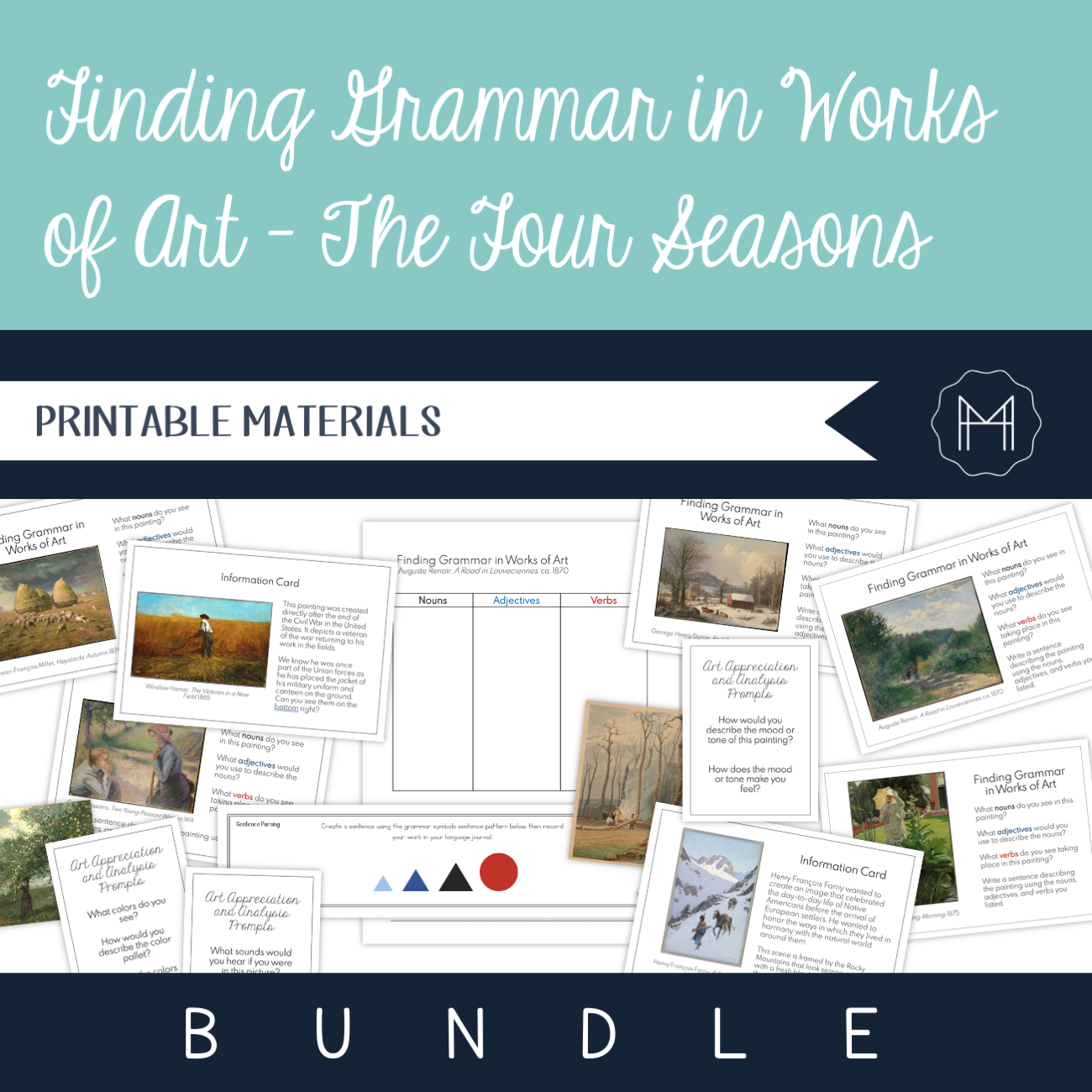The Modern Montessori Guide
Finding Grammar in Works of Art - The Four Seasons Bundle
Couldn't load pickup availability
This activity provides students with a creative extension for grammar review. When examining a piece of art, I challenge children to approach it as if they are reading the image. They can begin by skimming the illustration and then dig deeper, analyzing all the nooks and crannies.
Each task card contains an image, a caption identifying the artist, title, and creation date, and a series of directions pertaining to grammar. I’ve also included corresponding information cards for each painting that could be printed double-sided on the back of the task card. There are 56 works of art total including:
- Jean-François Millet, Haystacks: Autumn, 1874
- Yosa Buson, Autumn Landscape, 1780
- Alfred Sisley, The Road from Versailles to Louveciennes, 1879
- Paul Cézanne, Dish of Apples, 1876
- Joshua Cristall, Barking Timber in Wychwood Forest, Oxfordshire, 1818
- Camille Pissarro, The Harvest, Pontoise, 1881
- Wolfgang Adam Töpffer, Young Woman in the Vaudois after the Grape Harvest, 1821
- Winslow Homer, The Veteran in a New Field, 1865
- Vincent van Gogh, Women Picking Olives, 1889
- John Whetten Ehninger, October, 1867
- W. Herbert Dunton, Fall in the Foothills, 1933
- Edward Mitchell Bannister, Seaweed Gatherers, 1898
- George Catlin, View on the Wisconsin River, Winnebago Shooting Ducks, 1837
- Han Huang, Returning Home after Harvest, 17th Century
- George Harvey, Spring-Burning Fallen Trees in a Girdled Clearing, 1841
- James Tissot, Spring Morning, 1875
- Charles-François Daubigny, Apple Blossoms, 1873
- Auguste Renoir, A Road in Louveciennes, ca. 1870
- Artist Unknown, Vasanti Ragini, ca. 1710
- Georges Seurat, Study for "A Sunday on La Grande Jatte", 1884
- Henri Rousseau, The Banks of the Bièvre near Bicêtre, 1908
- Winslow Homer, Spring Farm Work - Grafting, 1870
- Qui Ying, Spring Festival on the River, 18th Century
- Max Bohm, Springtime in France, 1923
- Winslow Homer, Girl Picking Apple Blossoms, 1879
- Katsushika Hokusai, Cherry Blossom Viewing, Edo Period
- Winslow Homer, Spring Blossoms, Mid 1870
- Joseph Rubens Powell, Spring, 1800’s
- William Merritt Chase, At the Seaside, 1892
- Vincent van Gogh, Self-Portrait with a Straw Hat, 1898
- Camille Pissarro, Two Young Peasant Women, 1891
- Vincent van Gogh, Wheat Field with Cypresses, 1889
- Georges Seurat, Gray Weather, 1886
- Genga, Magpie on Viburnum Branch, 16th Century
- Jean-François Millet, Garden Scene, 1854
- Auguste Renoir, Nini in the Garden, 1876
- Ike Taiga, Landscape in Summer, 18th Century
- Edouard Manet, The Monet Family in Their Garden at Argenteuil, 1874
- Albert Bierstadt, The Rocky Mountains, Lander's Peak, 1863
- Richard Parkes Bonington, Roadside Halt, 1826
- Edouard Manet, Boating, 1874
- Paul Cézanne, The Fishermen, 1875
- George Henry Durrie, Red School House, 1858
- Suzuki Harunobu, The Snow Ball, 1770
- Frederic Edwin Church, Aurora Borealis, 1865
- Jonathan K. Trego and J. L. Williams, Trappers, 1855
- Henry François Farny, A Successful Hunt, 1906
- Abraham Rademaker, Snow Falling on a Dutch Town, 1881
- Winslow Homer, Lumbering in the Winter, 1821
- Robert Charles Dudley, The Atlantic Telegraph, 1866
- Aert van der Neer, Sports on a Frozen River, 1660
- Currier & Ives, A Ride to School, 1868
- Charles Parsons with Currier & Ives, Central Park, Winter – The Skating Pond, 1933
- Winslow Homer, A Winter Morning – Shovelling Out, 1871
- Johannes Abrahamsz Beerstraten, Skating at Sloten, near Amsterdam, Mid 1660s
- Currier & Ives, Winter Morning in the Country, 1873
In addition to the grammatical components, I have included “Art Appreciation and Analysis Prompts” that can be used alongside any of the images as an extension.
I recommend creating a “Grammar in Art” notebook that can be used to record the parts of speech and descriptive sentences for each piece of art. I have included independent images of each painting that could be cut out and pasted into the student’s notebook. On pages 30-33 I’ve also included models using the Montessori Parts of Speech symbols to help guide sentence construction. If you are looking for a review of the Parts of Speech, download a free copy of my Grammar Symbol Series explanation packet.
All images are categorized as Public Domain through the Metropolitan Museum of Art, The National Gallery of Art, and the Smithsonian Museums.
Share


